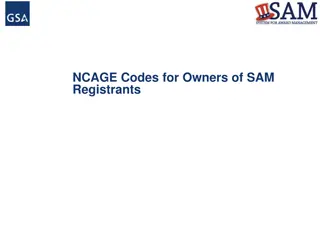Understanding Imputed Rental of Owner-Occupied Dwellings in Economic Activity
Explore the significance of treating owner-occupied dwellings as an economic activity, including methods like the rental equivalent method and user costs method. Discover why imputed rental is included in GDP calculations for consistency and how different countries' data compare. Learn about measurement approaches like the stratification method and the importance of assessing property rental value. Dive into the complexities of OOD services and their impact on GDP metrics.
Download Presentation

Please find below an Image/Link to download the presentation.
The content on the website is provided AS IS for your information and personal use only. It may not be sold, licensed, or shared on other websites without obtaining consent from the author. Download presentation by click this link. If you encounter any issues during the download, it is possible that the publisher has removed the file from their server.
E N D
Presentation Transcript
PFTAC GDP Compilation and Forecasting Workshop Measuring Imputed Rental of Owner-Occupied Dwellings Suva, Fiji October 17-21, 2016
Overview Why are owner-occupied dwellings treated as an economic activity? What happens if they are not? Rental equivalent method User costs method Self-assessment method
Services of owner occupied dwellings OOD services for own final consumption by owner occupiers included in the production boundary One of two exception to the general exclusion of own account production of services (>domestic staff) Households that own the dwellings they occupy treated as unincorporated enterprises and produce housing services consumed by the same households these services are imputed Not new in the 2008 SNA, all previous versions included this. 3
Why include imputed rental (OOD)? Simple answer: CONSISTENCY > The comparison of the level of GDP between two countries would be affected by a difference in the rate of ownership by households of their houses. The change in GDP between two periods would be affected by the change in the rate of ownership of households of their own dwellings. The imputed value of the income generated by such production is taxed in some countries. (SNA 6.34) This can be a big chunk of (modeled!) activity 4
OOD versus rentals in selected countries Final consumption of housing services, 2011, in % of GDP Country Actual rents Imputed Rents Total rents Canada 2.7 Czech Republic 2.0 Estonia 1.2 France 2.3 Germany 3.8 Hungary 0.4 Poland 0.8 Slovak Republic 0.6 Slovenia 0.4 Spain 1.5 United Kingdom 3.3 United States 2.6 8.1 6.4 5.9 7.9 5.3 6.2 3.5 4.4 6.1 7.0 9.7 8.1 10.8 8.4 7.0 10.2 9.0 6.6 4.3 4.9 6.5 8.5 13.0 10.7 5
Measurement approaches Stratification method (preferred) based on actual rentals combines information on the housing stock, broken down by various strata, with information on actual rentals paid in each stratum User-cost method (usually next best) separate estimates are made of IC, consumption of fixed capital, other taxes less subsidies on production and net operating surplus. Output of dwelling services is the sum of these components. Self-assessment method (can be weak) Owner-occupiers provide estimates of their property s rental value Administrative assessment (not common) E.g. government estimates for tax purposes 6
Stratification (rental equivalence) method Assumption: well organized and wide spread market for rented housing exists: output is the value of estimated rental that a tenant would pay for the same accommodation IC consists of spending on repairs and maintenance (but not capital!), assuming mortgage interest payments covered in overall FISIM estimate need to consider factors such as: location, neighborhood amenities, size and quality of dwelling in deciding estimated rental From expenditure side - output is recorded as household final consumption expenditure From income side, gross operating surplus equal to output less IC as no compensation of employees only rental/CFC 7
Stratification (rental equivalence) method Obtain an estimate of rent by stratum of the owner occupied dwelling stock Needs deep stratification for reliable estimate Good data on housing stock needed: rented /owned with detailed characteristics Use large data sources: Population and/or Housing censuses Rental and Housing surveys Household Budget Survey Administrative sources Base year calculation extrapolated / interpolated 8
User-cost approach Assumption: well organized and wide spread market for rented housing does not exist. What s the rule? Use if less than 25% of all dwellings actually rented (SNA 2008) More than half of the rented dwellings are occupied by foreigners paying high rents or employees paying low rents Rented dwellings are not evenly distributed across the country Output = sum of costs that determine owners rental values GO = IC+ other taxes on production + CFC+ Net operating Surplus (NOS) ( cost of capital ) i.e equiv to market rent CFC + NOS capital service provided by the dwelling 9
User-cost approach Intermediate consumption and other taxes easier to measure IC is sum of expenditures on maintenance and repair of OODs and net insurance premiums paid by owners NOS and CFC difficult components to estimate: Estimation of stock of OODs needed for CFC and NOS estimation - census responses useful Current value of stock x depreciation rate = CFC deciding rate of return to be applied on current value of stock of OODs to calculate NOS 10
User-cost approach Advanced method of estimating the current value stocks is using perpetual inventory method (PIM) Based on estimates of stock of asset types each period Assumes life-lengths, and hence depreciation, by asset type Adds up all the CFC by asset for a given period In absence of a proper PIM model, use simpler model: A house type X costs $25,000, life length is 25 years With linear depreciation, CFC is $1,000 a year, or 4% Need to account for price change over life span though Also need to split out house and land costs 11
How much are houses and land worth? 12
How much are houses worth? K4:for simplicity, values of dwellings assumed to decline same amount each year until reaching zero (linear decay) By measuring new builds each year we can guess the number of houses and average age of the stock- So the price of dwelling of average age equals the new price times the ratio of the remaining years that the dwelling of average age (A) will continue to exist to the expected service life (L) Pave = Pnew*(L-A)/L So in our example, if a new house type X now costs $50,000 and the average age of the stock is 12.5 years: Pave = $50,000 x (25-12.5)/25 = $25,000 So, if we have 10,000 of these houses, total value is $250m 13
Working out CFC of the housing stock If we can model the value the housing stock and the depreciation rate, we can work out the value of CFC that year So here, the value of the stock is $250m and the depreciation rate is 4%, so CFC = $250m x 0.04 =$10m But, we still need to estimate Net Operating Surplus (NOS), which is the annual return the owner requires to cover the cost of the house and the land 14
Estimating Net Operating Surplus NOS = (value of housing stock and the land on which they re built) x rate of return (ROR) What to use for the ROR: Best -Average rate on housing loans if mortgage market is well- established Next best - use the rate on long-term (8 years or more) corporate or government bonds Otherwise could apply a proportion to other loan rates (as mortgage rates would be lower than e.g. unsecured personal loans) or even just assume a plausible rate based on local knowledge So if stock = $250m, land =$50m and ROR = 10%, NOS = ($250+$50m) x 0.10 =$30m 15
Self-assessment method Households are asked how much they believe their dwellings could be rented out for Often in connection with HIES or censuses Experience shows that this method will usually overestimate the rental value In countries with low land/building values, large rural populations and small/non-existent rental markets, valuation is difficult! However, relatively easy to implement and easy to explain If HIES interviewers are trained well, possible to get reasonable estimates but essentially by asking about costs, so ties in to user-cost approach (be careful of interviewer bias though) Discussion rental mkts in your countries? 16
Exercise Hints Output = sum of costs that determine owners rental values GO = IC+ other taxes on production + CFC+ Net operating Surplus (NOS) ( cost of capital ) i.e equiv to market rent IC is sum of expenditures on maintenance and repair of OODs and net insurance premiums paid by owners 17























